
Change in "dwelling prices" (Units AND Houses combined) over past 12 months to 28 February 2024:
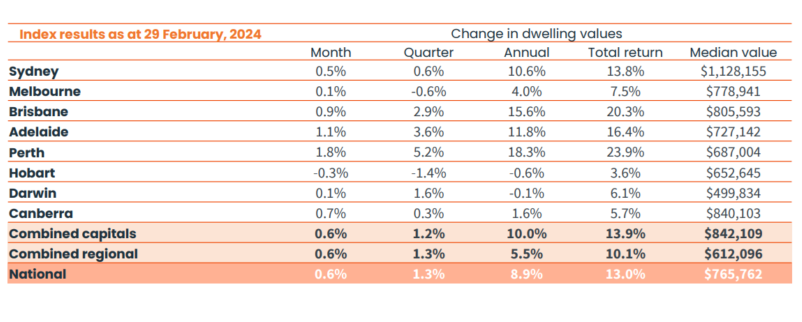
And here the current (Feb. 2024) "Asking Prices" that sellers are currently looking for. “Asking Prices” can be useful as these are a good leading indicator because they reflect the sentiment of sellers and the expectations for the future value of their properties:

1/2/24:Predictors of Australian Housing Market in 2024:
Drivers of Property Price Growth:
- Continued Population Growth: Strong population growth without sufficient new dwelling supply, leading to an extreme shortfall, putting upward pressure on house prices and rents.
- Anticipated Interest Rate Decline: Expectation of interest rates falling in the second half of 2024, coupled with potential relaxation of APRA's mortgage serviceability buffer (currently at 3%), increasing borrowing capacity.
- FOMO Effect: Fear of missing out (FOMO) as buyers realise strong recovery underway.
Challenges and Headwinds:
- Affordability Concerns: Stretched affordability, prompting buyers to opt for more affordable suburbs.
- Unemployment Goals: The Reserve Bank of Australia (RBA) aiming to increase unemployment to curb inflation, creating financial uncertainty and impacting buyer decisions.
- Consumer Sentiment: Lingering poor consumer sentiment from 2023, driven by economic uncertainty, peaking interest rates, and inflation concerns, likely to persist in the first half of 2024.
Market Trends:
- Differential in Property Types: Recent trends show houses outpacing apartments in value. The price gap between units and houses is at a record high. Family-friendly apartments in desirable locations could experience strong “catch-up” capital growth.
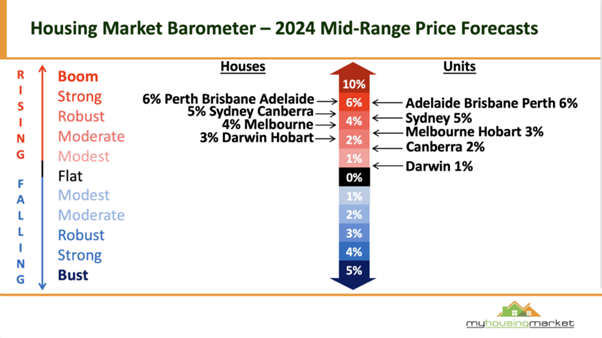
PERTH
The beachside suburbs of outer metro Perth experienced the largest gains in value across all Australia in 2023, with Western Australia dominating the list of top coastal suburbs with the highest annual capital gains.
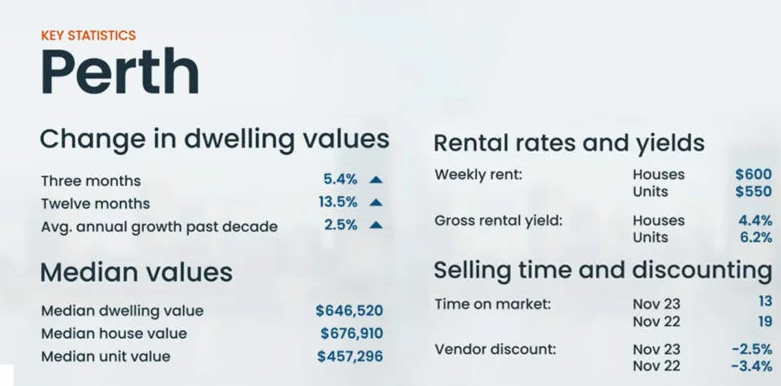
Perth, like all other Australian capital cities is suffering from a supply-led imbalance.
Perth listings are almost 40% below the five-year average, while estimated purchasing activity is a bit over 25% above the five-year average.
But in the other cities, a strong increase in advertised for sale properties means buying conditions in early 2024 were in favour of buyers, as higher stock levels provide more choice, less urgency, and greater opportunities to negotiate. The same can't be said for Perth or Brisbane, where advertised stock levels remain remarkably low.
While property price growth is expected to be lower in 2024 compared to last year, there is a positive aspect: you have the opportunity to outperform the national market by strategically investing in the right property and location.
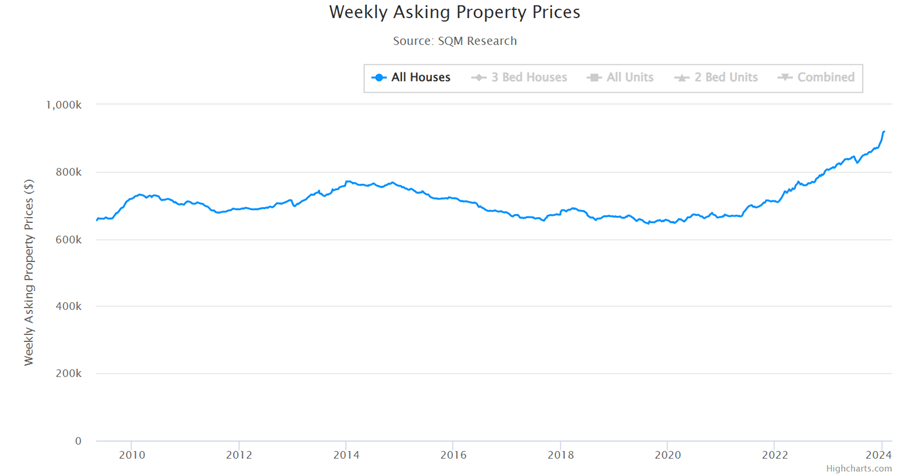
The Perth market is very different from the other Australian cities. Just look at that long period of Zero growth from 2010.
But actually Perth OVERTOOK Melbourne back in 2019, and for a brief period also overtook Sydney!
The market is not easily explained. So if you are interested in either Buying or Selling in Perth, feel free to schedule a no obligation call for 45 minutes where can go through in detail the market. Remember, I don't SELL houses (or apartments!) so there is no hidden agenda.
I provide advisory services to certain types of buyers and sellers, and am always happy to discuss the market with ANYONE as my business is very selective, doesn't suit most people, but relies on referrals from people just like you who I have helped without any obligation or commitment.
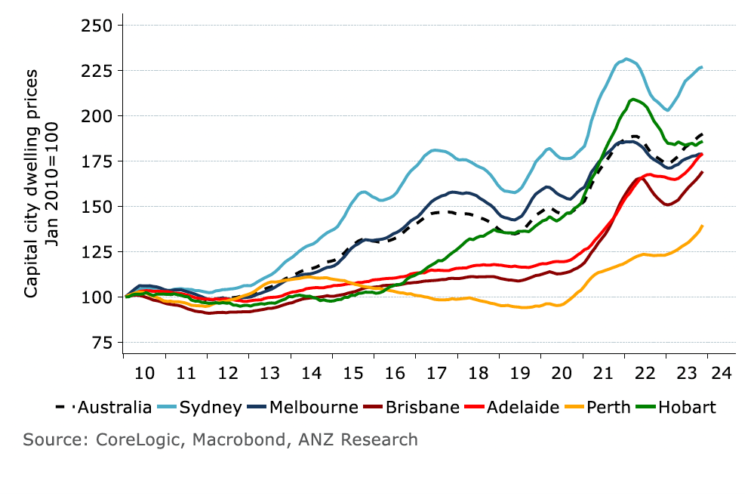
Here's what the major Australian banks are forecasting for property prices in Perth in 2024:
- ANZ forecasts capital city property prices to lift 6 per cent, with Perth tipped to rise by 7-8 per cent
- CBA expects capital city prices to lift 5 per cent, with Perth at 5 per cent.
- NAB predicts prices across the capitals to rise an average of 5.4 per cent. Prices are expected to lift 6.2 per cent in Perth.
- Westpac forecasts 6 per cent growth across the combined capitals. Perth is pencilled in for the highest growth at 10 per cent.
You can always beat the averages too by carefully considered purchasing.
-
Apart from Location – Location – Location is there ANOTHER Golden Rule of Property Investing in Australia?
YES there is. It is the QUALITY of your property that is of major importance to it’s financial success.

KEY POINTS
- The quality of the property determines long-term investment returns.
- Average-quality property yields average returns; above-average quality leads to above-average returns.
- Combined with strategic locations near the water, city hubs, parks, shops, schools and supermarkets, helps ensure investment success. Wherever possible, focus in inner and middle ring properties ONLY.
- Focused Investment Energy:
- Direct energy towards asset quality working with your professional property buyers agent.
- Outsource all other matters (tax, borrowing, property management, building inspections etc.) to advisors.
- Attributes of Quality Property:
- Sustained buyer demand exceeding supply.
- Appreciating value/prices in the long run.
- High-quality property is scarce.
- Factors Impacting Supply and Demand:
- In prime investment locations, supply is fixed or diminishing.
- Supply includes land supply and dwelling type/style.
- Land Supply Dynamics:
- Well-established, blue-chip suburbs have fixed and finite land supply.
- Outer suburbs may have abundant land supply due to releases within a 20km radius.
- Property Type and Style Effect on Supply:
- High-land-value locations see stable house supply; apartments can change more readily.
- Example: Victorian style houses have finite supply, potentially diminishing.
- Buyer Demand Exceeding Supply:
- Buyer demand refers to potential buyers desiring property in a certain location.
- Demand substantially exceeding supply leads to rising property prices.
- Imbalance in Supply and Demand:
- Invest where buyer demand substantially exceeds supply.
- Notionally, 10 buyers for every seller ensures price stability despite changes in supply or demand.
- Long-Term Price Support:
- Despite changes, the number of buyers exceeds sellers, supporting prices.
- Prices remain resilient even during supply increases or demand reductions.

Tips: Location Matters: Look for properties in inner, middle-ring and beach suburbs.
- Proximity to City Center:
- Suburbs close to the city centre, the river and very importantly in Perth, the beaches, as these tend to perform better over the long term.
- Value Appreciation Factors:
- Properties closer to the CBD and water generally experience faster value appreciation.
- Supported by research from the Australian Housing and Urban Research Institute.
- Research Confirmation:
- Research confirms that suburbs near the CBD, water, beaches with high demand, employment opportunities, and limited available land, outperform outer suburbs.
- Gentrification Impact:
- Gentrification has significantly influenced property values in inner- and middle-ring suburbs.
- Demographic Shifts:
- Gentrification resulted from demographic changes, not deliberate planning policies.
- Exodus of industry, migrants, and workers paved the way for gentrification in inner suburbs.
- Changing Demographics:
- Changing demographics, including declining household size, contributed to the appeal of small inner suburban dwellings.
- Ideal accommodation for professionals working in or near the CBD.
- Attractions for Gentrifiers:
- Gentrifiers initially attracted by job diversity, educational opportunities, and lifestyles in inner suburbs.
- Trend continues as more and more Australians are increasingly opting for urban living over traditional suburban homes.
FINAL WORDS / CONCLUSION
NEGATIVE REAL INTEREST RATES
Despite the rises in interest rates over 2022 and 2023, Australia still has negative real interest rates.
That is inflation is higher than cash rate interest (before tax) so it is inevitable that those sitting on cash - losing money in real terms daily - would look to the property market.
Meanwhile, mortgage debt to GDP has been falling because of higher inflation. The bears hate this, because it means in effect the Australian housing market is not as geared as it once was.
MONEY SUPPLY
The Reserve Bank has really pulled back its printing of money to low levels, which should help inflation in 2024.
REAL GDP
Slowed not yet negative. This is a risk, if Australia falls into recession. Nominal GDP seems to have a strong long term relationship to house prices. In 2022 the rise was 12%.
Watch the nominal GPD figures for a macro view on house prices.
HOUSE PRICES
The Perth house market is currently extremely strong.
Prices remain (at the time of writing) affordable compared to Brisbane, Sydney and Melbourne.

The risk in Perth housing is of course related to commodities. If you are comfortable with that risk, there is a fortune to be made in Perth property over the short, medium and long term.
Buy along the northern train line.
But interest rates, inflation, external and internal migration, the GDP and unemployment will all play a part. However, I will be wrong if there is an ongoing commodities downturn.
Of all the markets, it is essential in Perth to buy a house, not an apartment, and to use a Buyers Agent.
I have access to off market properties, pocket listings, as well as all properties currently listed. I use research, data and extensive contacts with agents to get many properties before they are publicly advertised.
Those properties that are already on the market now, I use all my knowledge, skills, experience, data and research as well as know-how to help you secure a great buy, working against the seller and their agent.






